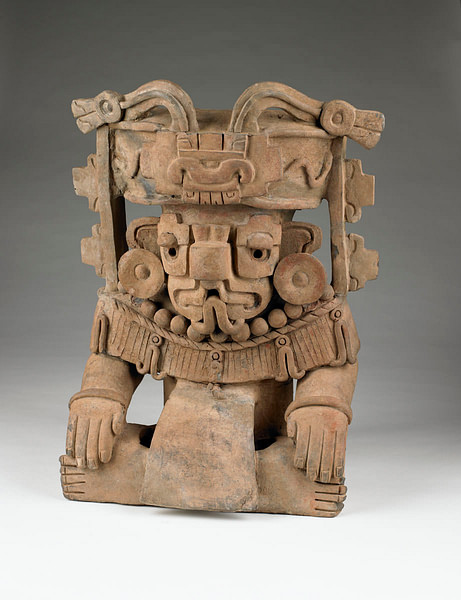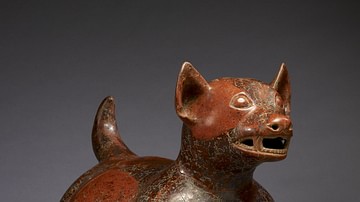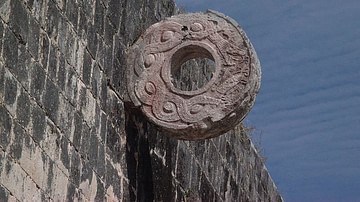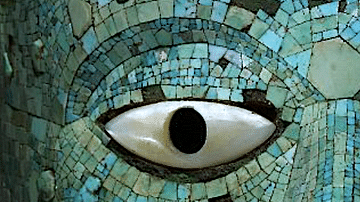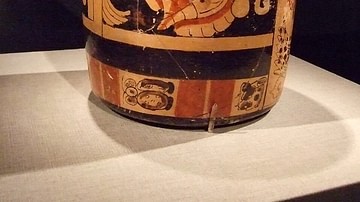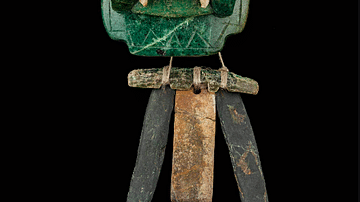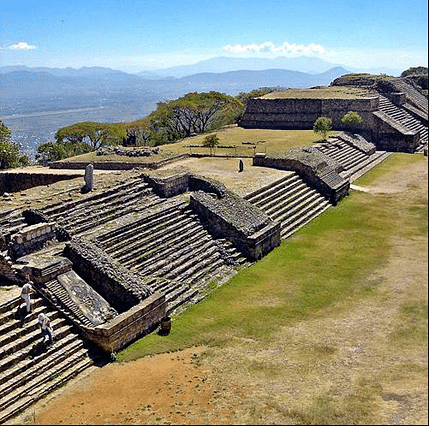
The Zapotecs, known as the 'Cloud People', dwelt in the southern highlands of central Mesoamerica, specifically, in the Valley of Oaxaca, which they inhabited from the late Preclassic period to the end of the Classic period (500 BCE - 900 CE). Their capital was first at Monte Albán and then at Mitla, they dominated the southern highlands, spoke a variation of the Oto-Zapotecan language, and profited from trade and cultural links with the Olmec, Teotihuacan and Maya civilizations.
Origins & Development
The Zapotecs grew from the agricultural communities which grew up in the valleys in and around Oaxaca. In the Preclassic period they established fruitful trade links with the Olmec civilization on the Gulf Coast which allowed for the construction of an impressive capital site at Monte Albán and for the Zapotec to dominate the region during the Classic period. The city, strategically placed overlooking the three main valleys, evolved over centuries, beginning around 500 BCE and remaining the cultural centre until the demise of the civilization around 900 CE.
The Zapotec had other significant settlements besides the capital and over 15 elite palaces have been identified in the surrounding valleys. Indeed, the Zapotec may be divided into three distinct groups: the Valley Zapotec (based in the Valley of Oaxaca), the Sierra Zapotec (in the north), and the Southern Zapotec (in the south and east, nearer the Isthmus of Tehuantepec). The major Zapotec sites, spread across the Y-shaped Valley of Oaxaca, include the capital Monte Albán, Oaxaca, Huitzo, Etla, San Jose Mogote, Zaachila, Zimatlan, Ocotlan, Abasolo, Tlacolula, and Mitla. The latter would become the most important Zapotec city from c. 900 CE and is notable for its buildings arranged around plazas which are richly decorated with reliefs of geometrical designs.
By the late Preclassic period Zapotec cities show a high level of sophistication in architecture, the arts, writing and engineering projects such as irrigation systems. For example, at Hierve el Agua there are artificially terraced hillsides irrigated by extensive canals fed by natural springs. Evidence of contact with other Mesoamerican cultures can be seen, for example, at the site of Dainzu, which has a large stone-faced platform with reliefs showing players of the familiar Mesoamerican ball game wearing protective headgear. We also know of very close relations between the Zapotec and the peoples based at Teotihuacan in the Basin of Mexico. Indeed, at Teotihuacan there was even a quarter of the city specifically reserved for the Zapotec community.
Religion
The Zapotec pantheon is as rich and bewildering as any other Mesoamerican religion is to modern eyes with the standard deities for such important agencies on the human condition as rain, sun, wind, earth, and war. Some of the most important gods were the Bat-god - the god of corn and fertility, Beydo - god of seeds and wind, Cocijo (who had a human body with jaguar and serpent features with a forked tongue) - the rain and lightning god, Pitao Cozobi - the corn god, Copijcha (symbolised by the macaw) - the god of the sun and war, Coquebila - god of the earth's centre, Huechaana - a mother goddess also associated with hunting and fishing, Kedo - god of justice, Ndan - the androgynous god of the oceans, Pixee Pecala the god of love, and Coqui Xee - the creator god who represented infinity.
In addition, individual cities often had their own patron deities, for example, Coquenexo ('Lord of Multiplication') patron of Zoquiapa, Coqui Bezelao and Xonaxi Quecuya (gods of death and the underworld) patrons of Mitla and Teocuicuilco, and Cozicha Cozee (another war god) patron of Ocelotepec.
Offerings, prayers and sacrifices were offered to these deities in the hope of their favourable intervention in human affairs, for example, to bring rain vital for crops, to end droughts or bring fertility to the land and its population. Also, in common with other Mesoamerican cultures, the Zapotec had 20 day names represented by various glyphs such as Chilla (crocodile), Pija (drought) and Xoo (earthquake); once again they often represent the fundamental elements that could drastically affect daily life.
Monte Albán
Built on a series of mountain plateau at an altitude of 400 m, the city of Monte Albán was the residential, ritual and economic centre of the Zapotec civilization. It replaced, between 500 and 450 BCE, San José Mogote as the most important settlement in the Valley. It also became the burial site of Zapotec kings for over a thousand years. The city particularly flourished in the late Preclassic period when its population was as high as 20,000 people and again between 400 and 700 CE when the population rose to 25,000 and the city ruled over some 1,000 settlements spread across the Valley.
The majority of the structures visible today on the main plaza date to the Classic period with the notable exception of the Temple of the Danzantes, a stone platform structure which was constructed when the site was first occupied (Monte Alban I). The name Danzantes derives from the dancing relief figures decorating the platform. 300 figures are identifiable, some seem to be old, single-toothed males, some have been mutilated, whilst still others seem to be almost swimming - who they represent is not known. Other relief stones from the temple also provide the first certainly identified written texts in Mexico showing an alphabet with semantic and phonetic elements (as yet undeciphered). There is also a system of numbers represented by dots and bars and glyphs for the 260-day year based on 20 day names and 13 numbers with the 52-year cycle of the Calendar Round.
Finds at the site from this period include a large quantity of pottery, usually made with a fine grey clay, sometimes with incised figures similar to the Danzantes, and typically in the form of spouted vases and bowls set on a tripod. Another interesting type is the whistling jar, a jar with two chambers which when used to pour liquid, expelled air from the second chamber to create a whistling sound. The Zapotec were also skilled sculptors and single effigy figures, groups of figures and urns survive both in clay and more precious goods such as jade.
The city further developed between 150 BCE and 150 CE to create Monte Albán II. Dating from this phase is a large stone-faced building shaped like an arrow head (Building J) which points southwest and is aligned with the Capella star. The building is covered with carved text and reliefs which indicate regional conquests, illustrated by the upside down heads of defeated kings.
In the subsequent Classic period Monte Albán III arose and, influenced by Teotihuacan, saw the construction of an I-shaped ball court and the Temple-Patio-Altar complex that would be copied at sites across the Valley. In addition, over 170 underground tombs have been excavated, many with vaults and antechambers with richly painted walls, which attest to the wealth of the city. The tombs also show signs of being regularly re-opened, illustrating the Zapotec preoccupation with ancestor worship.

Decline
Quite why the city and the Zapotec civilization collapsed at Monte Albán is not known, only that there is no trace of violent destruction and that it was contemporary with the demise of Teotihuacan and a general increase in inter-state conflict. The site continued to be significant, though, as it was adopted by the later Mixtec as a sacred site and place of burial for their own kings. The Zapotecs did not disappear completely, however, for in the early Post-Classic period they established a new, smaller centre at Mitla, known to them as Lyobaa or 'Place of Rest' which also had many fine buildings including the celebrated Hall of the Columns. The site continued to be occupied even up to the Spanish conquest.
